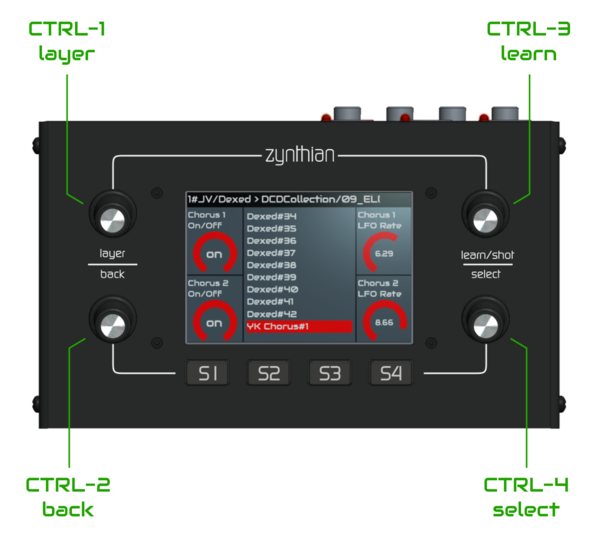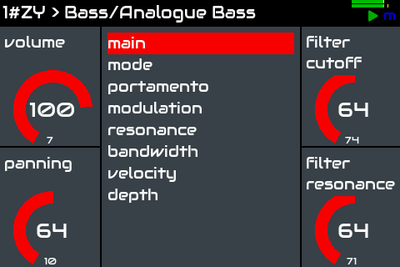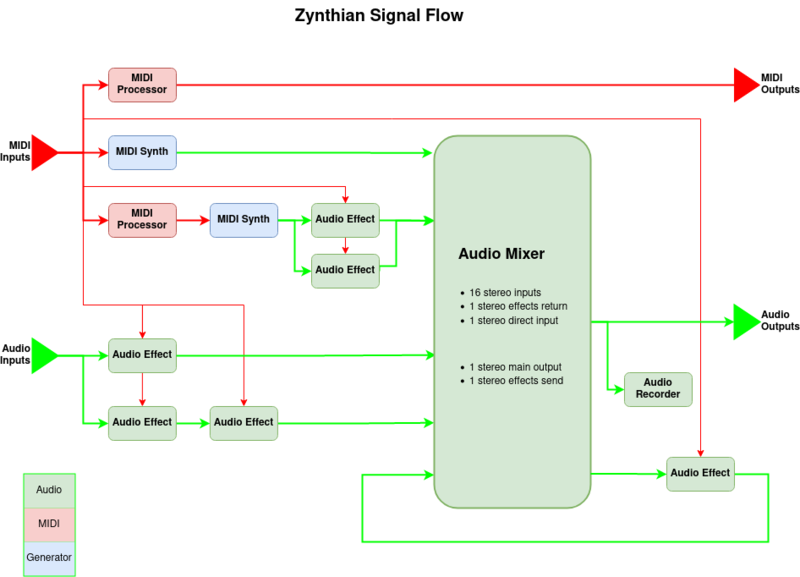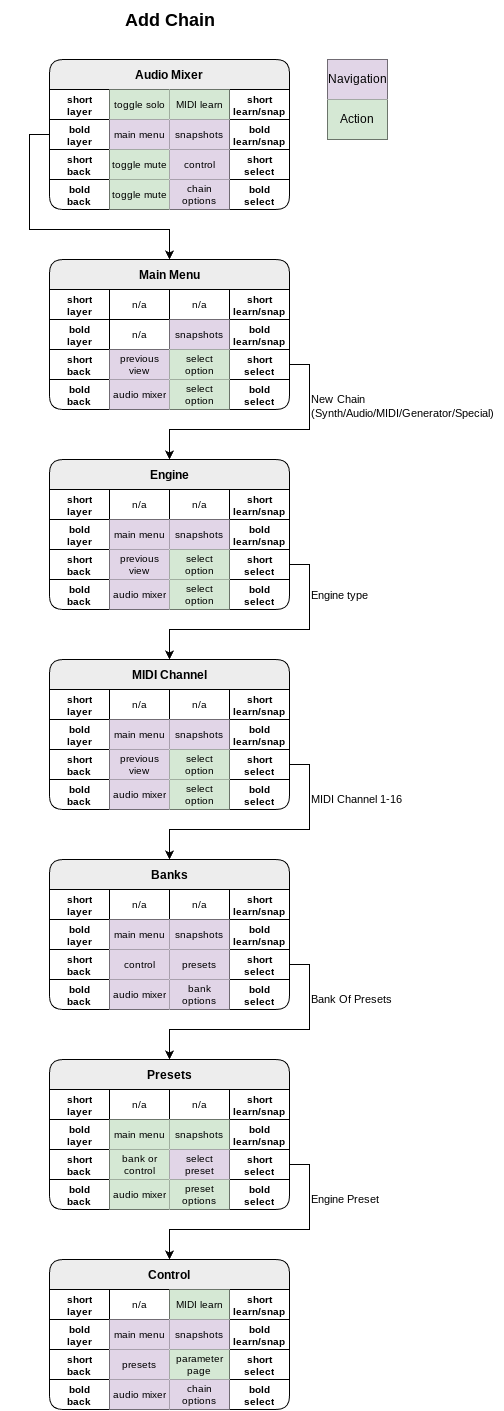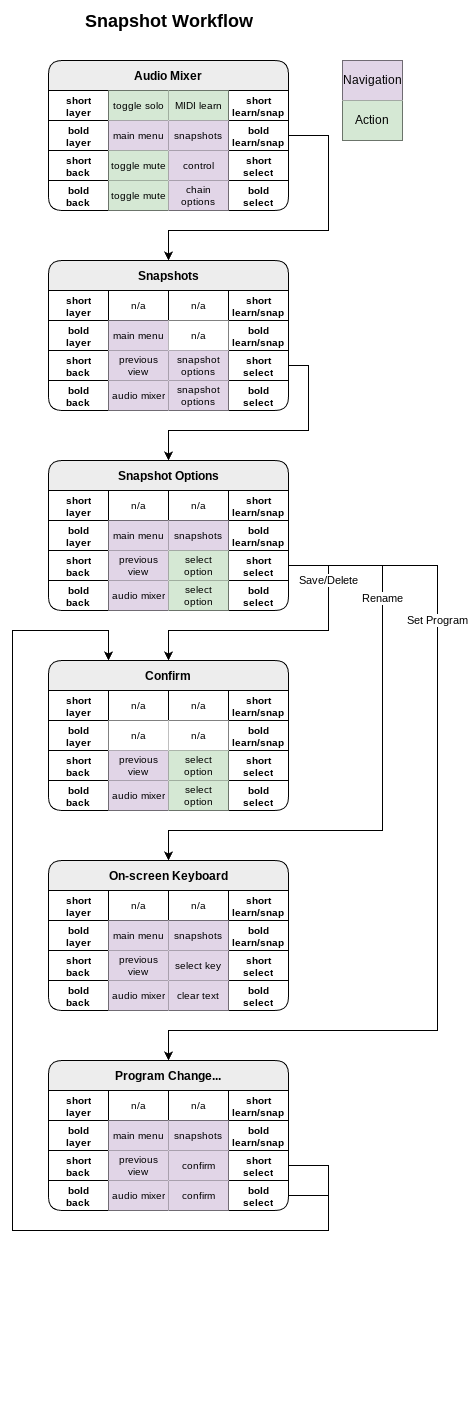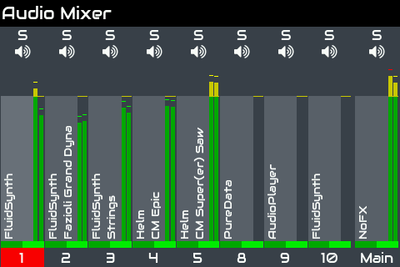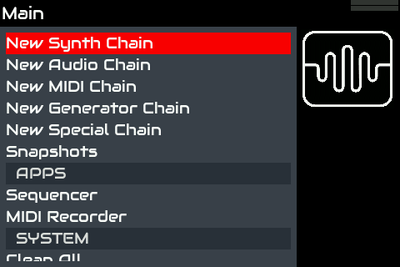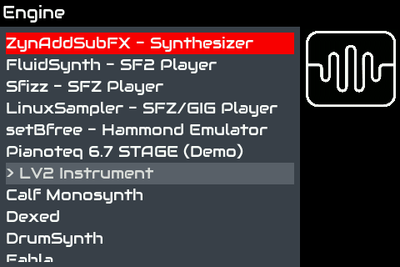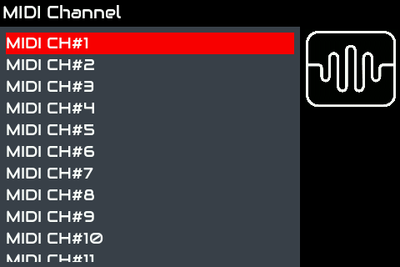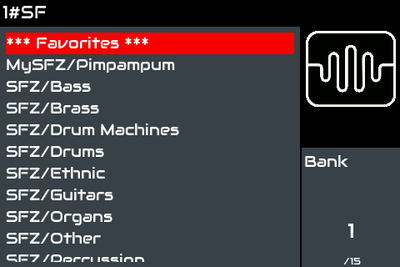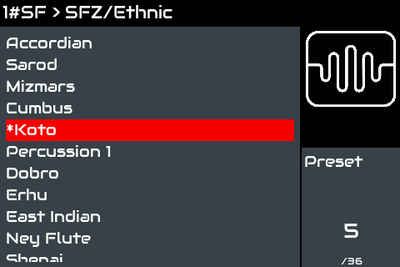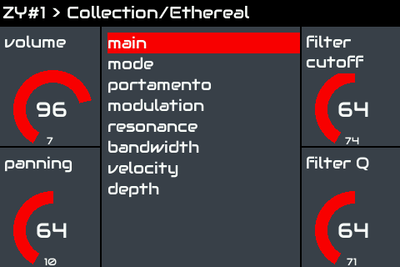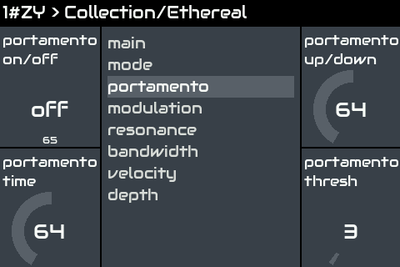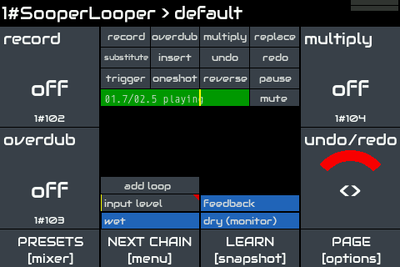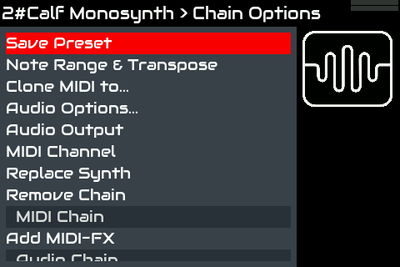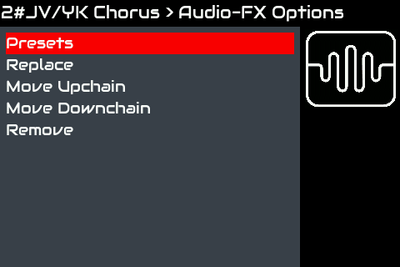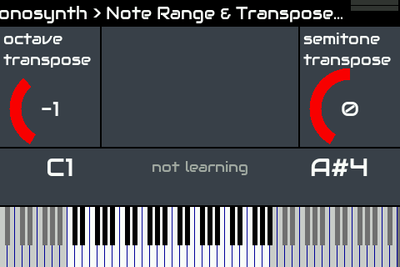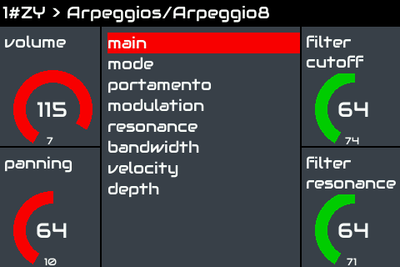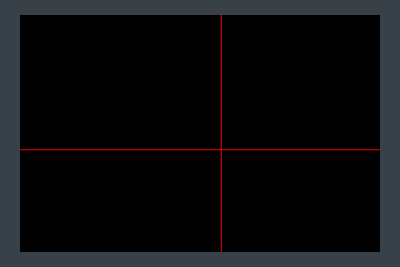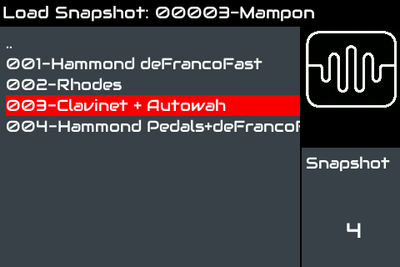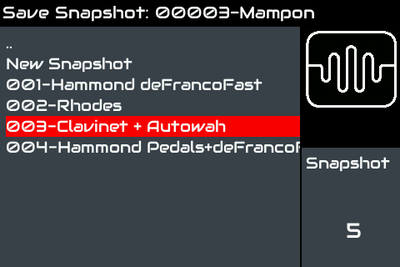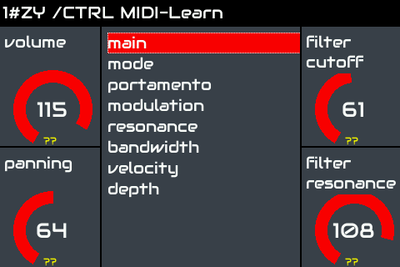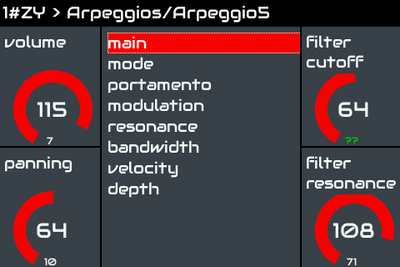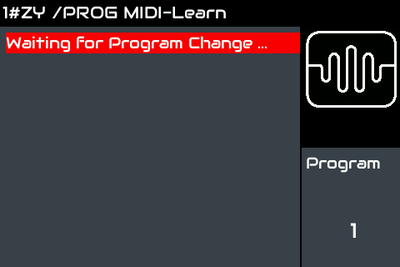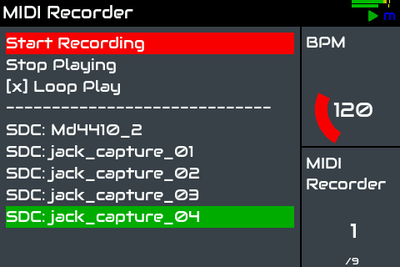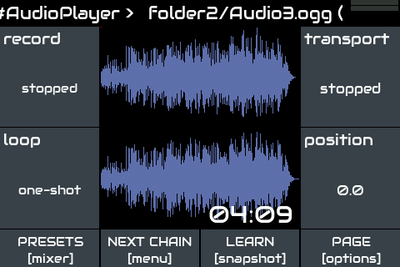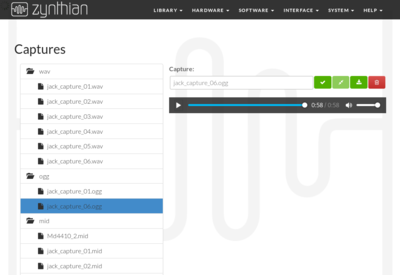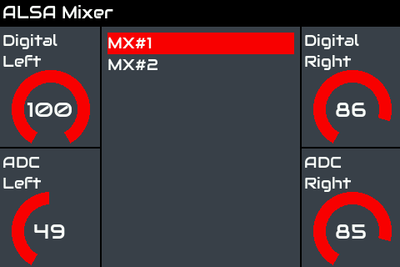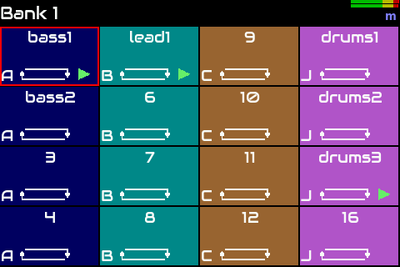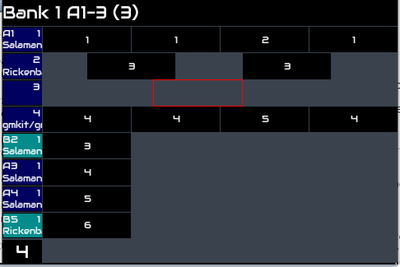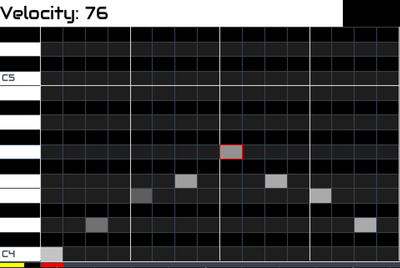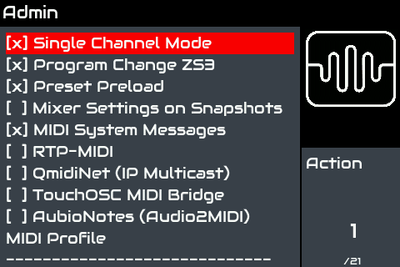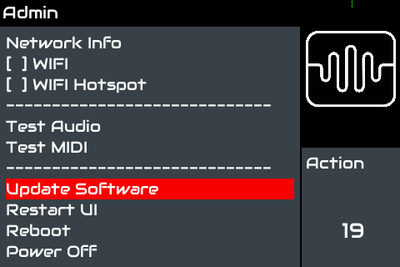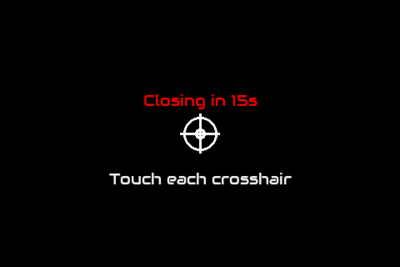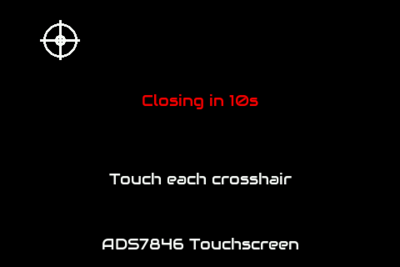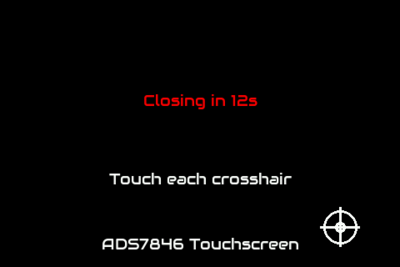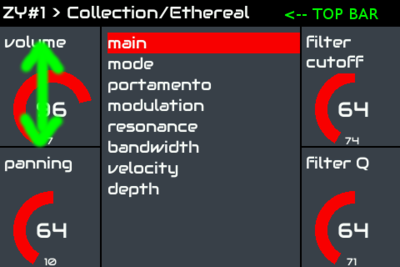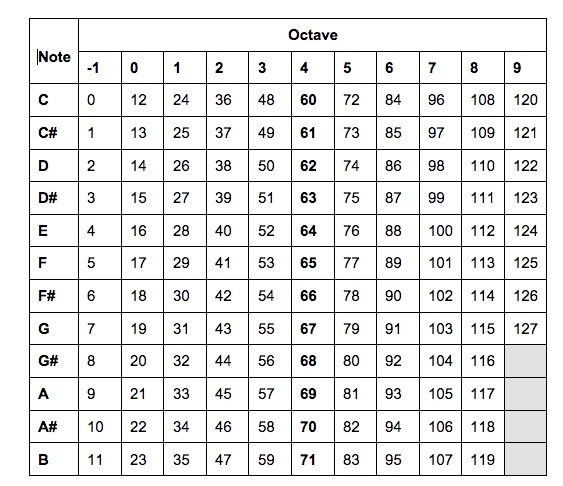Difference between revisions of "Zynthian UI User Guide - V1/V4"
(Update MIDI CUIA table to be synced with latest stable) |
|||
| (47 intermediate revisions by 2 users not shown) | |||
| Line 2: | Line 2: | ||
=General Concepts= | =General Concepts= | ||
| − | The Zynthian UI | + | The core Zynthian UI consists of a display and four knobs with push switches. You can also control the UI with a touchscreen, a mouse or a keyboard (computer keyboard or MIDI keyboard, both!) |
| − | The four knobs & switches are the primary control mechanism to navigate the UI: selecting options on menus and adjusting | + | The four knobs & switches are the primary control mechanism to navigate the UI: selecting options on menus and adjusting parameters. The knobs can act as assignable MIDI / OSC controllers for parameters (frequently lots of them!). Most operations may be performed with the touchscreen but some may not be intuitive. See the section on [[#Touch_Screen_UI|touchscreen]] and comments throughout this documentation. |
[[File:Zynthian v4 top legend.png|600px|center]] | [[File:Zynthian v4 top legend.png|600px|center]] | ||
| Line 19: | Line 19: | ||
* '''Info Screen''': It displays info about an operation, like "Update Software", or "Network Info". | * '''Info Screen''': It displays info about an operation, like "Update Software", or "Network Info". | ||
* '''Key Range & Transpose Screen''': It allows to choose the key range and transpose notes by octaves or semitones. | * '''Key Range & Transpose Screen''': It allows to choose the key range and transpose notes by octaves or semitones. | ||
| + | * '''Mixer''': The main screen from you manage the chains. | ||
* etc. | * etc. | ||
| Line 33: | Line 34: | ||
Although some push actions depend of context (current screen), there are some actions that are global and will work from any screen: | Although some push actions depend of context (current screen), there are some actions that are global and will work from any screen: | ||
| − | * '''Bold-Back''': | + | * '''Bold-Back''': Mixer |
* '''Long-Layer''': Step Sequencer | * '''Long-Layer''': Step Sequencer | ||
* '''Long-Back''': Admin Menu | * '''Long-Back''': Admin Menu | ||
| Line 43: | Line 44: | ||
<br clear=all> | <br clear=all> | ||
| − | =The Title Bar= | + | ==The Title Bar== |
[[File:zynthian_ui_control_status.png|400px|right]] | [[File:zynthian_ui_control_status.png|400px|right]] | ||
| Line 53: | Line 54: | ||
<br clear=all> | <br clear=all> | ||
| − | =The Status Area= | + | ==The Status Area== |
[[File:Status display.png|400px|right]] | [[File:Status display.png|400px|right]] | ||
| Line 106: | Line 107: | ||
=The Zynthian UI Workflow= | =The Zynthian UI Workflow= | ||
| − | Zynthian workflow is based around chains of audio generators | + | Zynthian workflow is based around chains of audio/MIDI generators & processors feeding an audio summing mixer. |
| + | |||
| + | [[File:Zynthian Signal Flow.png|800px|center]] | ||
| + | |||
| + | <br clear=all> | ||
| + | ===Chains=== | ||
| + | Chains are a key concept of the Zynthian. The first thing you will do after powering-on your Zynthian is probably to create a chain. (It does little without any chains!) | ||
| + | |||
| + | A chain is composed of one or more interconnected blocks, capable of generating or processing audio & MIDI. Each chain is normally assigned to a MIDI channel. These blocks are chained in the same order they are created, but you can change this order from the '''Chain Options''' menu. The first block created in a chain is the '''root''' and it determines the chain's type: | ||
| + | |||
| + | * '''Synth Chain''' => Receives MIDI note-events and generate audio output | ||
| + | * '''Audio Chain''' => Receives audio-input and generates audio-output | ||
| + | * '''MIDI Chain''' => Receives MIDI-input and generates MIDI-output | ||
| + | * '''Generator Chain''' => Generate audio output using an algorithm | ||
| + | * '''Special Chain''' => Does not fit any other chain type, e.g. MOD-UI pedalboard, Pure Data patch, etc. | ||
| + | |||
| + | The chain's type can't be changed. Depending of the chain's type, MIDI effects can be added to the start of the chain and audio effects can be added to the end of the chain. These can be arranged as serial or parallel paths. | ||
| + | |||
| + | All audio effects in a chain receive all the MIDI events on the assigned channel (this should be improved!). | ||
| + | |||
| + | When you select '''NEW Chain''', you create a new chain, choosing its root engine, a free MIDI channel and if available, bank & preset. You can create up to 16<sup>*</sup> chains, one per MIDI channel. | ||
| + | |||
| + | (*) If Master Channel is enabled then only 15 chains can be created. | ||
| + | |||
| + | Having several chains on the same MIDI channel is not allowed currently. If you want two or more chains to play in unison (like being on the same MIDI channel), you can use the "Clone" feature, which allows you to bind several chains while keeping MIDI CCs and other MIDI messages (Program Change, Channel Pressure, etc.) independent. | ||
| − | |||
<br clear=all> | <br clear=all> | ||
| + | ===Stage and Multitimbral Modes=== | ||
| + | |||
| + | By default Zynthian starts in '''stage mode'''. Stage mode is a kind of ''Omni-On'' mode, what means all MIDI messages are sent to the selected chain in your zynthian. You don't need to worry about the MIDI channel your keyboard/controller is using. You can change the instrument you play by selecting it in your zynthian or using ZS3's Programs Change feature (see below). | ||
| − | + | In the other hand, '''multitimbral mode''' allows receiving and managing separately every MIDI channel. Each external MIDI controller will drive the chain that is assigned to that controller's MIDI channel, e.g. a chain assigned to MIDI channel 1 will listen for MIDI messages on MIDI channel 1 only<sup>*</sup>. | |
| − | Navigation between views is performed by pressing buttons or using the touchscreen. | + | (*) MIDI Continuous Controllers are handled differently. See section on [[#MIDI-learning_.2F_binding|MIDI Learning & binding]]. |
| + | |||
| + | <br clear=all> | ||
| + | ===Navigation=== | ||
| + | The home screen is the Mixer and it's always reachable by pressing bold-Back. Navigation between views is performed by pressing buttons or using the touchscreen. Most destructive changes, e.g. removing chains, will request confirmation. Operations that take time to complete may show an animated zynthian logo representing progress. | ||
Navigation, default actions and common workflows are shown in the following graphs: | Navigation, default actions and common workflows are shown in the following graphs: | ||
| − | <gallery mode=" | + | |
| − | Image:Main Views.png|''[[ | + | <gallery mode="packed" heights="800"> |
| − | + | Image:Main Views.png|''[[#The_UI_Screens|Main Views]]'' | |
| − | |||
| − | |||
| − | |||
</gallery> | </gallery> | ||
| − | + | <gallery mode="packed" heights="1400"> | |
| + | Image:Add chain workflow.png|''[[#Main_Menu|Add Chain]]'' | ||
| + | Image:Snapshot workflow.png|''[[#Load_.2F_Save_Snapshot|Manage Snapshots]]'' | ||
| + | </gallery> | ||
<br clear=all> | <br clear=all> | ||
| Line 130: | Line 161: | ||
=The UI Screens= | =The UI Screens= | ||
| − | == | + | ==Mixer== |
[[File:Audio mixer.png|400px|right]] | [[File:Audio mixer.png|400px|right]] | ||
| − | The | + | The mixer view is the home screen and pressing '''bold-BACK''' should always navigate to this screen. It displays a strip for each configured chain plus a strip for the main mixbus. The quantity of strips displayed may be configured using webconf. If there are more chains than can be displayed, the screen can be scrolled horizontally by selecting a higher / lower chain or dragging the bottom legend strip. |
| − | Each audio chain | + | ===Audio Chains=== |
| + | Each audio chain have the following mixer controls: | ||
* '''Fader''' adjusts the audio level | * '''Fader''' adjusts the audio level | ||
| Line 143: | Line 175: | ||
* '''Solo''' toggles the audio contribution to the solo mixbus<sup>*</sup> | * '''Solo''' toggles the audio contribution to the solo mixbus<sup>*</sup> | ||
| − | + | (*) When solo is enabled on any chain, all other chains are muted. Solo can be enabled for multiple chains, each contributing to the output. Operating the main mixbus solo will disable solo on all chains. | |
Each audio chain also has a stereo audio level meter indicating peak programme level with peak hold bar. This may be disabled in admin menu or webconf to reduce CPU load if required. | Each audio chain also has a stereo audio level meter indicating peak programme level with peak hold bar. This may be disabled in admin menu or webconf to reduce CPU load if required. | ||
| − | + | ===MIDI Chains=== | |
| + | MIDI only (non-audio) chains show in the mixer view without any audio mixer controls nor meter. | ||
| − | + | ===Contextual Actions=== | |
| − | + | * Rotate '''SELECT knob''' or tap on a strip to select a chain. | |
| − | + | * Rotate '''LAYER knob''' or drag the touchscreen to adjust the selected chain's fader. | |
| − | + | * Rotate '''BACK knob''' to adjust the selected chain's balance / pan. | |
| − | + | * Rotate '''LEARN/SHOT knob''' or drag the touchscreen to adjust the main mixbus fader. | |
| − | + | * Press '''short-LAYER''' to toggle solo of the selected chain. | |
| − | + | * Press '''short-BACK''' to toggle mute of the selected chain. | |
| − | + | * Press '''short-LEARN/SHOT''' to enter MIDI learn mode. | |
| − | + | * Press '''short-SELECT''' to access the chain's Control View. | |
| − | + | * Press '''bold-LAYER''' to access the main menu. | |
| − | + | * Press '''bold-LEARN/SHOT''' to access snapshots. | |
| + | * Press '''bold-SELECT''' to access the selected chain's options. | ||
==Main Menu== | ==Main Menu== | ||
| Line 172: | Line 206: | ||
* '''New Generator Chain''' adds an audio generator chain | * '''New Generator Chain''' adds an audio generator chain | ||
* '''New Special Chain''' adds a non-standard or special chain | * '''New Special Chain''' adds a non-standard or special chain | ||
| − | * '''Snapshots''' | + | * '''Snapshots''' manage snapshots |
* '''Sequencer''' access the step sequencer | * '''Sequencer''' access the step sequencer | ||
* '''MIDI Recorder''' access the standard MIDI file recorder / player | * '''MIDI Recorder''' access the standard MIDI file recorder / player | ||
| Line 179: | Line 213: | ||
* '''Admin''' access configuration menu | * '''Admin''' access configuration menu | ||
* '''PANIC! All Notes OFF''' resets all MIDI engines | * '''PANIC! All Notes OFF''' resets all MIDI engines | ||
| − | |||
| − | |||
| − | |||
| − | |||
| − | |||
| − | |||
| − | |||
| − | |||
| − | |||
| − | |||
| − | |||
| − | |||
| − | |||
| − | |||
| − | |||
| − | |||
| − | |||
| − | |||
| − | |||
| − | |||
| − | |||
| − | |||
| − | |||
| − | |||
| − | |||
| − | |||
<br clear=all> | <br clear=all> | ||
| Line 227: | Line 235: | ||
This screen is shown in various contexts: | This screen is shown in various contexts: | ||
| − | * | + | * When creating a new chain, after you have selected the engine. Only unused channels are listed. |
* When you change the assigned MIDI channel from the Chain Options menu. Only unused channels are listed. | * When you change the assigned MIDI channel from the Chain Options menu. Only unused channels are listed. | ||
| − | * When you clone MIDI for a chain from the Chain Options menu. | + | * When you clone MIDI for a chain, from the Chain Options menu. |
Playing a note on a connected MIDI controller will cause the list to jump to the MIDI channel of the note played. This can assist with assigning chains to controllers. | Playing a note on a connected MIDI controller will cause the list to jump to the MIDI channel of the note played. This can assist with assigning chains to controllers. | ||
| Line 237: | Line 245: | ||
== Bank selector== | == Bank selector== | ||
[[File:Zynthian_ui_bank_list.png|400px|right]] | [[File:Zynthian_ui_bank_list.png|400px|right]] | ||
| − | Presets (instruments, patches, sound designs, etc.) for engines may be organized into banks. Choose a bank to see the list of presets | + | Presets (instruments, patches, sound designs, etc.) for engines may be organized into banks. You can access engine's bank list by pressing '''short-BACK''' from within its presets list. Choose ('''short-SELECT''') a bank to see the list of presets on it. |
<br clear=all> | <br clear=all> | ||
| − | + | '''Bold-SELECT''' or touch and hold a bank on the touchscreen will show the '''Bank Options menu'''. User banks may be renamed or deleted. Some engines do not allow banks to be manipulated in which case this will have no effect. | |
| − | + | '''Short-BACK''' to return to the Control View without selecting. | |
| − | |||
| − | Short | ||
<br clear=all> | <br clear=all> | ||
==Preset selector== | ==Preset selector== | ||
[[File:Zynthian_ui_preset_list.png|400px|right]] | [[File:Zynthian_ui_preset_list.png|400px|right]] | ||
| − | Once you have chosen a bank, the preset screen will be shown. Choose a preset to load the instrument / sound / patch and the Control View will be shown. | + | Once you have chosen a bank, the preset screen will be shown. Choose a preset to load the instrument / sound / patch / etc. and the Control View will be shown. |
<br clear=all> | <br clear=all> | ||
| − | To change preset | + | To change the selected preset for a engine in a chain, navigate to its Control View then short press BACK to access the list of presets. Use the SELECT encoder to highlight the required preset and '''short-SELECT''' (or tap, if using touchscreen) to select the preset. The engine will configure with the preset values and the Control View will be displayed. |
| − | Bold | + | '''Bold-SELECT''' a preset (or touch and hold on the touchscreen) will show the '''Preset Options menu'''. A preset may be added to or removed from a list of favorites, renamed or deleted. Some engines do not allow presets to be manipulated and will only show the Favourite option. (Saving presets is performed in the chain options menu described later.) |
| − | If the '''preload with note-on''' feature is enabled in the admin menu or webconf, you can audition the presets by playing notes. When you do so, the highlighted preset will be pre-loaded without pressing SELECT. | + | If the '''preload with note-on''' feature is enabled in the admin menu or webconf, you can audition the presets by playing notes. When you do so, the highlighted preset will be pre-loaded without pressing SELECT. Note that some engines may be slow to load presets in which case it may be necessary to play the note more than once to hear the new preset sound. |
| − | You can return to the bank screen, without selecting any preset, by short | + | You can return to the bank screen, without selecting any preset, by pressing '''short-BACK'''. The previously selected instrument will be restored, e.g. if a preset has been pre-loaded (auditioned). |
| − | Press bold SELECT to | + | Press '''bold-SELECT''' to manage the preset including adding to your favorites. The favorites list can be shown by pressing '''short-LEARN/SHOT''' in the Bank or Preset View. |
Not all engines support presets. If no presets are configured then this screen is not shown. | Not all engines support presets. If no presets are configured then this screen is not shown. | ||
| Line 267: | Line 273: | ||
==Control View== | ==Control View== | ||
[[File:Zynthian_ui_instrument_control_01.png|400px|right]] | [[File:Zynthian_ui_instrument_control_01.png|400px|right]] | ||
| − | The Control View shows the controls available for each engine within a chain. It is shown after adding a chain, adding an engine to a chain or by short | + | The Control View shows the controls available for each engine within a chain. It is shown after adding a chain, adding an engine to a chain or by pressing '''short-SELECT''' (or tapping the bottom legend strip in the mixer view). Your instrument is now enabled and playable and you can modify its parameters. |
The controls are shown in groups of four (or fewer) on several pages. Each hardware knob controls a parameter displayed in the control view or the control may be dragged up and down on the touchscreen. Controls may toggle between two values, e.g. on / off, lists of values, e.g. sine, square, triangle or continuously adjustable values, e.g. 0%..100%. If there are a lot of possible values the hardware knobs will accelerate progress if rotated fast, e.g. stepping by one value when turned slowly and stepping by 10 values when rotated fast. This allows fine and coarse selection of a parameter from a single knob. | The controls are shown in groups of four (or fewer) on several pages. Each hardware knob controls a parameter displayed in the control view or the control may be dragged up and down on the touchscreen. Controls may toggle between two values, e.g. on / off, lists of values, e.g. sine, square, triangle or continuously adjustable values, e.g. 0%..100%. If there are a lot of possible values the hardware knobs will accelerate progress if rotated fast, e.g. stepping by one value when turned slowly and stepping by 10 values when rotated fast. This allows fine and coarse selection of a parameter from a single knob. | ||
| Line 274: | Line 280: | ||
[[File:Zynthian_ui_instrument_control_03.png|400px|right]] | [[File:Zynthian_ui_instrument_control_03.png|400px|right]] | ||
There is a list that shows the pages of controls available. | There is a list that shows the pages of controls available. | ||
| − | To change page, short | + | To change page, press '''short-SELECT''' - the list of pages turns grey, '''rotate SELECT''' to highlight the required page then short press again to select the page. If there are fewer than three pages then '''short-SELECT''' will step through each page. Alternatively, tap the required page on the touchscreen. When a page is selected its controls will be shown. Depending on the configuration, some pages may have fewer than four controls and some engines have no adjustable parameters in which case there will be no control pages. |
The pages for the controls for each engine within a chain are shown separated by a title indicating to which engine subsequent pages belong. | The pages for the controls for each engine within a chain are shown separated by a title indicating to which engine subsequent pages belong. | ||
| Line 288: | Line 294: | ||
==Chain Options== | ==Chain Options== | ||
[[File:Chain options.png|400px|right]] | [[File:Chain options.png|400px|right]] | ||
| − | + | Pressing '''bold-SELECT''' when in the '''Mixer View''' or '''Control View''' will show the '''Chain Options menu''', allowing to manipulate the chain: | |
* '''Save Preset''' will allow saving of a engine's configuration as a preset that may later be selected from the preset list. This is only available if the engine supports manipulation of presets. If a chain has several engines then a list of engines will be displayed before naming the preset. | * '''Save Preset''' will allow saving of a engine's configuration as a preset that may later be selected from the preset list. This is only available if the engine supports manipulation of presets. If a chain has several engines then a list of engines will be displayed before naming the preset. | ||
| Line 312: | Line 318: | ||
[[File:Zynthian_ui_layer_effect_options.png|400px|right]] | [[File:Zynthian_ui_layer_effect_options.png|400px|right]] | ||
| − | + | Select an effect in the list for opening the effect options menu, that allows manipulating chain elements: | |
* '''Presets''' shows list of available presets for the effect | * '''Presets''' shows list of available presets for the effect | ||
| Line 408: | Line 414: | ||
Unlearn operations require confirmation. | Unlearn operations require confirmation. | ||
| − | Of course, MIDI-learning configuration, including CC mappings, is stored and restored with snapshots | + | Of course, MIDI-learning configuration, including CC & PC mappings, is stored and restored with snapshots. |
| − | |||
| − | |||
<br clear=all> | <br clear=all> | ||
| Line 416: | Line 420: | ||
====MIDI Program Change & ZS3 (SubSnapShots)==== | ====MIDI Program Change & ZS3 (SubSnapShots)==== | ||
[[File:Zynthian_ui_midi_zs3_learn.png|400px|right]] | [[File:Zynthian_ui_midi_zs3_learn.png|400px|right]] | ||
| − | A ZS3 (SubSnapShot) saves the zynthian state in the context of the current snapshot. When recalled, the saved state is restored. The | + | A ZS3 (SubSnapShot) saves the zynthian state in the context of the current snapshot. When recalled from the UI or by MIDI Program Change, the saved state is restored. The chain's layout is defined for the snapshot and it can't be changed across ZS3s, but the rest of state is saved in ZS3: bank/preset, engine parameters, mixer settings, clone & key range settings, etc. Snapshots can be slow to load as each engine needs to be started. ZS3 is much faster as the presets are restored and parameters adjusted. Some ZS3 may be slower due to the way some engines load presets, e.g. changing instrument within Pianoteq is slower than recalling a preset of the same instrument. |
| − | |||
| − | |||
The idea behind this feature is to have a fast preset-change mechanism that can be used on stage. In combination with the “Stage Mode” feature, it turns Zynthian into a “Stage-Beast”. You can prepare a snapshot for the full performance, and use ZS3s for fast changes between songs or even within a song. | The idea behind this feature is to have a fast preset-change mechanism that can be used on stage. In combination with the “Stage Mode” feature, it turns Zynthian into a “Stage-Beast”. You can prepare a snapshot for the full performance, and use ZS3s for fast changes between songs or even within a song. | ||
| Line 431: | Line 433: | ||
You can recall the stored ZS3 by sending the same MIDI Program Change or selecting it from the ZS3 list. ZS3s are saved and restored within snapshots so remember to save the snapshot. | You can recall the stored ZS3 by sending the same MIDI Program Change or selecting it from the ZS3 list. ZS3s are saved and restored within snapshots so remember to save the snapshot. | ||
| + | |||
| + | ZS3 will restore configuration for all chains in multitimbral mode and for the currently selected (active) chain only in stage mode. | ||
Bold press SELECT to manipulate ZS3: | Bold press SELECT to manipulate ZS3: | ||
| Line 437: | Line 441: | ||
* '''Update''' replaces the ZS3 with the current configuration | * '''Update''' replaces the ZS3 with the current configuration | ||
* '''Delete''' removes the ZS3 | * '''Delete''' removes the ZS3 | ||
| − | |||
| − | |||
| − | |||
| − | |||
| − | |||
| − | |||
| − | |||
<br clear=all> | <br clear=all> | ||
| − | |||
| − | |||
==MIDI Recording and Playback== | ==MIDI Recording and Playback== | ||
| Line 483: | Line 478: | ||
<br clear=all> | <br clear=all> | ||
| − | |||
==Audio Recording and Playback== | ==Audio Recording and Playback== | ||
| Line 616: | Line 610: | ||
| − | {{NoteBox| The resistive touchscreen works better with a stylus. Finger is too coarse. It's strongly recommended to run the calibration using a stylus. }} | + | {{NoteBox| The resistive touchscreen works better with a stylus. Finger is too coarse. It's strongly recommended to run the calibration using a stylus. |
| + | Screen calibration is beneficial to resistive touch screens and less likely to be useful for capacitive touchscreens which tend to be well absolutely aligned.}} | ||
<br clear=all> | <br clear=all> | ||
| Line 641: | Line 636: | ||
==KeyBindings: Controlling the UI with a computer keyboard== | ==KeyBindings: Controlling the UI with a computer keyboard== | ||
| − | The user interface may be driven using a USB keyboard, e.g. QWERTY, Dvorak, etc. Key assignment and their combinations can be modified with the webconf tool. The default key bindings are: | + | The user interface may be driven using a USB keyboard, e.g. QWERTY, Dvorak, etc. Key assignment and their combinations can be modified with the webconf tool, e.g. http://zynthian.local/ui-keybind. The default key bindings are: |
{| class="wikitable" | {| class="wikitable" | ||
| Line 654: | Line 649: | ||
| ALL_SOUNDS_OFF || Shift || Space | | ALL_SOUNDS_OFF || Shift || Space | ||
|- | |- | ||
| − | | BACK_DOWN || | + | | BACK_DOWN || Ctrl || Comma |
|- | |- | ||
| − | | BACK_UP || | + | | BACK_UP || Ctrl || Period |
|- | |- | ||
| − | | LAYER_DOWN || Shift || | + | | LAYER_DOWN || Shift+Ctrl || Less |
|- | |- | ||
| − | | LAYER_UP || Shift || | + | | LAYER_UP || Shift+Ctrl || Greater |
|- | |- | ||
| POWER_OFF || Ctrl || End | | POWER_OFF || Ctrl || End | ||
| Line 670: | Line 665: | ||
| RESTART_UI || Shift || Home | | RESTART_UI || Shift || Home | ||
|- | |- | ||
| − | | SELECT_DOWN || None || | + | | SELECT_DOWN || None || Comma |
|- | |- | ||
| − | | SELECT_UP || None || | + | | SELECT_UP || None || Period |
|- | |- | ||
| − | | SNAPSHOT_DOWN || | + | | SNAPSHOT_DOWN || Shift || Less |
|- | |- | ||
| − | | SNAPSHOT_UP || | + | | SNAPSHOT_UP || Shift || Greater |
|- | |- | ||
| START_AUDIO_PLAY || Ctrl || a | | START_AUDIO_PLAY || Ctrl || a | ||
| Line 694: | Line 689: | ||
| STOP_MIDI_RECORD || Shift || m | | STOP_MIDI_RECORD || Shift || m | ||
|- | |- | ||
| − | | SWITCH_BACK_BOLD || Shift || BackSpace | + | | SWITCH_BACK_BOLD || Shift || l or BackSpace or Escape |
|- | |- | ||
| − | | SWITCH_BACK_LONG || Ctrl || BackSpace | + | | SWITCH_BACK_LONG || Ctrl || l or BackSpace or Escape |
|- | |- | ||
| − | | SWITCH_BACK_SHORT || None || BackSpace | + | | SWITCH_BACK_SHORT || None || l or BackSpace or Escape |
|- | |- | ||
| − | | SWITCH_LAYER_BOLD || Shift|| | + | | SWITCH_LAYER_BOLD || Shift|| i |
|- | |- | ||
| − | | SWITCH_LAYER_LONG || Ctrl || | + | | SWITCH_LAYER_LONG || Ctrl || i |
|- | |- | ||
| − | | SWITCH_LAYER_SHORT || None|| | + | | SWITCH_LAYER_SHORT || None|| i |
|- | |- | ||
| − | | SWITCH_SELECT_BOLD || Shift || | + | | SWITCH_SELECT_BOLD || Shift || l |
|- | |- | ||
| − | | SWITCH_SELECT_LONG || Ctrl || | + | | SWITCH_SELECT_LONG || Ctrl || l |
|- | |- | ||
| − | | SWITCH_SELECT_SHORT || None || | + | | SWITCH_SELECT_SHORT || None || l |
|- | |- | ||
| − | | SWITCH_SNAPSHOT_BOLD || Shift || | + | | SWITCH_SNAPSHOT_BOLD || Shift || o |
|- | |- | ||
| − | | SWITCH_SNAPSHOT_LONG || Ctrl || | + | | SWITCH_SNAPSHOT_LONG || Ctrl || o |
|- | |- | ||
| − | | SWITCH_SNAPSHOT_SHORT || None || | + | | SWITCH_SNAPSHOT_SHORT || None || o |
|- | |- | ||
| − | | TOGGLE_AUDIO_PLAY || | + | | TOGGLE_AUDIO_PLAY || Ctrl+Alt || a |
|- | |- | ||
| − | | TOGGLE_AUDIO_RECORD || | + | | TOGGLE_AUDIO_RECORD || Alt || a |
|- | |- | ||
| − | | TOGGLE_MIDI_PLAY || | + | | TOGGLE_MIDI_PLAY || Ctrl+Shift || m |
|- | |- | ||
| − | | TOGGLE_MIDI_RECORD || | + | | TOGGLE_MIDI_RECORD || Alt || m |
|} | |} | ||
| Line 748: | Line 743: | ||
4 RELOAD_KEY_BINDING E-1 | 4 RELOAD_KEY_BINDING E-1 | ||
5 LAST_STATE_ACTION F-1 | 5 LAST_STATE_ACTION F-1 | ||
| + | 6 EXIT_UI F#-1 | ||
10 ALL_NOTES_OFF A#-1 | 10 ALL_NOTES_OFF A#-1 | ||
| Line 767: | Line 763: | ||
40 STOP_MIDI_PLAY E2 Stop: 0xFC | 40 STOP_MIDI_PLAY E2 Stop: 0xFC | ||
| + | 41 ARROW_UP F2 | ||
| + | 42 ARROW_DOWN F#2 | ||
| + | 43 ARROW_RIGHT G2 | ||
| + | 44 ARROW_LEFT G#2 | ||
| + | |||
| + | 45 ZYNPOT_UP A2 | ||
| + | 46 ZYNPOT_DOWN A#2 | ||
| + | |||
| + | 48 BACK C3 | ||
| + | 49 NEXT C#3 | ||
| + | 50 PREV D3 | ||
51 SELECT D#3 | 51 SELECT D#3 | ||
| + | |||
52 SELECT_UP E3 | 52 SELECT_UP E3 | ||
53 SELECT_DOWN F3 | 53 SELECT_DOWN F3 | ||
| Line 774: | Line 782: | ||
56 LAYER_UP G#3 | 56 LAYER_UP G#3 | ||
57 LAYER_DOWN A3 | 57 LAYER_DOWN A3 | ||
| − | 58 | + | 58 LEARN_UP A#3 |
| − | 59 | + | 59 LEARN_DOWN B3 |
64 SWITCH_BACK_SHORT E4 | 64 SWITCH_BACK_SHORT E4 | ||
| Line 787: | Line 795: | ||
60 SWITCH_LAYER_SHORT C4 | 60 SWITCH_LAYER_SHORT C4 | ||
61 SWITCH_LAYER_BOLD C#4 | 61 SWITCH_LAYER_BOLD C#4 | ||
| − | + | 68 SWITCH_LAYER_LONG B3 | |
71 SWITCH_SNAPSHOT_SHORT B4 | 71 SWITCH_SNAPSHOT_SHORT B4 | ||
| Line 797: | Line 805: | ||
82 SCREEN_BANK A#5 | 82 SCREEN_BANK A#5 | ||
83 SCREEN_PRESET B5 | 83 SCREEN_PRESET B5 | ||
| − | |||
| − | 90 | + | 85 SCREEN_MIDI_RECORDER C#6 |
| + | 86 SCREEN_ALSA_MIXER D6 | ||
| + | 87 SCREEN_STEPSEQ D#6 | ||
| + | 88 SCREEN_BANK E6 | ||
| + | 89 SCREEN_PRESET F6 | ||
| + | 90 SCREEN_CALIBRATE F#6 | ||
| + | |||
91 MODAL_SNAPSHOT_SAVE G6 | 91 MODAL_SNAPSHOT_SAVE G6 | ||
92 MODAL_AUDIO_RECORDER G#6 | 92 MODAL_AUDIO_RECORDER G#6 | ||
| Line 808: | Line 821: | ||
100 LAYER_CONTROL E7 | 100 LAYER_CONTROL E7 | ||
| + | 101 LAYER_OPTIONS F7 | ||
| + | 102 MENU F#7 | ||
| + | 103 PRESET G7 | ||
| + | 104 FAVS G#7 | ||
| + | 105 ZYNPAD A7 | ||
[[File:2Oct_Keyboard_CUIA.png|600px|Keyboard]] | [[File:2Oct_Keyboard_CUIA.png|600px|Keyboard]] | ||
Revision as of 01:06, 8 January 2023
1 General Concepts
The core Zynthian UI consists of a display and four knobs with push switches. You can also control the UI with a touchscreen, a mouse or a keyboard (computer keyboard or MIDI keyboard, both!)
The four knobs & switches are the primary control mechanism to navigate the UI: selecting options on menus and adjusting parameters. The knobs can act as assignable MIDI / OSC controllers for parameters (frequently lots of them!). Most operations may be performed with the touchscreen but some may not be intuitive. See the section on touchscreen and comments throughout this documentation.
There are two main screen-layout types:
- Selector Screen: a list of items that you can scroll and select with the SELECT knob (CTRL-4)
- Controller Screen: 4 control widgets in the corners (one for each knob), with label and value indicators (graphic and numeric). In the middle there is a list of controller screens, each one mapping 4 controllers which you can use to change the engine parameters.
Most of Zynthian UI screens belongs to one of these 2 categories, however, other screen-layouts do exist:
- Confirmation Screen: It will ask you to confirm some operation.
- XY Controller Screen: It allows to modify 2 parameters at once using the touch interface.
- Info Screen: It displays info about an operation, like "Update Software", or "Network Info".
- Key Range & Transpose Screen: It allows to choose the key range and transpose notes by octaves or semitones.
- Mixer: The main screen from you manage the chains.
- etc.
There are 3 types of push actions that can be performed, depending on how long you hold down the knob / button (or hold your finger on the touch-display).
- Short push: Less than 0.3 seconds
- Bold push: Between 0.3 and 2 seconds
- Long push: More than 2 seconds (until the long-action is triggered!)
These timing values are the default ones. You can adjust them to your personal feeling from the UI options in the web-based configuration tool (webconf).
Some push actions depends of context. The SELECT knob is mainly used to navigate and a short push on it will select an item on a "Selector Screen". Inside a "Controller Screen", short pushes can be used to rotate between chains (LAYER knob) or between controller pages (SELECT knob). "Bold-pushes" are normally intended as shortcuts for jumping to specific screen like "chain options", "main menu", etc. Pushing the BACK knob generally close the current modal-screen or jumps to the previous screen in the workflow sequence.
Although some push actions depend of context (current screen), there are some actions that are global and will work from any screen:
- Bold-Back: Mixer
- Long-Layer: Step Sequencer
- Long-Back: Admin Menu
- Long-Learn: All Notes Off
- Long-Select: Power Off
Later versions of zynthian kits include 4 extra push buttons, labelled as S1 to S4. By default, these buttons are assigned to MIDI Program Change 1-4, but this can be easily changed from the webconf's Wiring Layout menu.
1.1 The Title Bar
The title bar has 2 functions:
- Kind of Breadcrumb, normally showing the screen title or current chain information: MIDI channel, engine, bank & preset
- Back-button, when using the touch-interface (Not very intuitive, but Zynthian-UI was not designed with touch-navigation in mind)
1.2 The Status Area
On the top-right corner is an area where some useful information is displayed in real time:
- Audio peak-meter or CPU load-bar: horizontal bars indicating peak audio level or CPU load (configured in webconf)
- Status Icons: indication of various states
| Status Icons Legend | ||
|---|---|---|
| m | MIDI-IN | It's shown when MIDI messages are received. Underscore indicates system message such as MIDI clock. |
| XRun | It's shown when there are XRuns. This may be accompanied by clicks and pops on audio output. This means the CPU can't process or transfer audio fast enough and you should consider disabling some CPU-hungry option (like VNC, headphones, etc.) or reducing the complexity of your chains. | |
| Under-voltage | Zynthian is working in a degraded state, with the CPU frequency capped to 600-800 MHz, trying to stabilize the system and avoid a system crash. You shouldn't see that icon and if you do so, you should consider looking for a better power source. | |
| Over-temperature | Zynthian is working in a degraded state, with the CPU frequency capped to 600-800 MHz, trying to stabilize the system and avoid a system crash. You shouldn't see that icon and if you do so, you should improve heat dissipation (using a heat sink, etc.) | |
| Recording Audio / MIDI | Audio or MIDI is being recorded. | |
| Playing Audio / MIDI | Audio or MIDI track is being played. | |
1.2.1 The Peak Meter
The Audio Peak meter is shown by default. The meter covers the range -50dBFS to 0dBFS, i.e. maximum permissible level at full scale (far right) down to 50dB below (far left):
- The green segment covers the range -50dBFS to -10dBFS.
- The yellow segment covers the range -10dBFS to -3dBFS.
- The red segment covers the range -3dBFS to 0dBFS.
There are independent meters for left and right channels which monitor the system output, i.e. the mix of audio that feeds the Zynthian output. Level decays with a logarithmic rule, taking one second to decay to -200dBFS so will decay to -50dBFS (the displayed range) in about quarter of a second. Peaks are displayed instantly, i.e. the attack of the meter is immediate (*). The peak hold bar remains for two seconds or until a higher peak is reached.
(*) Meter is updated 5 times per second so there can be 200 ms delay in peak being displayed.
Alternately, the "CPU-load" bar can be enabled from webconf, replacing the Audio Peak meter. The CPU-load bar shows the CPU usage as calculated by the Jack Audio Server:
This is a running average of the time it takes to execute a full process cycle for all clients as a percentage of the real time available per cycle determined by the buffer size and sample rate.
2 The Zynthian UI Workflow
Zynthian workflow is based around chains of audio/MIDI generators & processors feeding an audio summing mixer.
2.1 Chains
Chains are a key concept of the Zynthian. The first thing you will do after powering-on your Zynthian is probably to create a chain. (It does little without any chains!)
A chain is composed of one or more interconnected blocks, capable of generating or processing audio & MIDI. Each chain is normally assigned to a MIDI channel. These blocks are chained in the same order they are created, but you can change this order from the Chain Options menu. The first block created in a chain is the root and it determines the chain's type:
- Synth Chain => Receives MIDI note-events and generate audio output
- Audio Chain => Receives audio-input and generates audio-output
- MIDI Chain => Receives MIDI-input and generates MIDI-output
- Generator Chain => Generate audio output using an algorithm
- Special Chain => Does not fit any other chain type, e.g. MOD-UI pedalboard, Pure Data patch, etc.
The chain's type can't be changed. Depending of the chain's type, MIDI effects can be added to the start of the chain and audio effects can be added to the end of the chain. These can be arranged as serial or parallel paths.
All audio effects in a chain receive all the MIDI events on the assigned channel (this should be improved!).
When you select NEW Chain, you create a new chain, choosing its root engine, a free MIDI channel and if available, bank & preset. You can create up to 16* chains, one per MIDI channel.
(*) If Master Channel is enabled then only 15 chains can be created.
Having several chains on the same MIDI channel is not allowed currently. If you want two or more chains to play in unison (like being on the same MIDI channel), you can use the "Clone" feature, which allows you to bind several chains while keeping MIDI CCs and other MIDI messages (Program Change, Channel Pressure, etc.) independent.
2.2 Stage and Multitimbral Modes
By default Zynthian starts in stage mode. Stage mode is a kind of Omni-On mode, what means all MIDI messages are sent to the selected chain in your zynthian. You don't need to worry about the MIDI channel your keyboard/controller is using. You can change the instrument you play by selecting it in your zynthian or using ZS3's Programs Change feature (see below).
In the other hand, multitimbral mode allows receiving and managing separately every MIDI channel. Each external MIDI controller will drive the chain that is assigned to that controller's MIDI channel, e.g. a chain assigned to MIDI channel 1 will listen for MIDI messages on MIDI channel 1 only*.
(*) MIDI Continuous Controllers are handled differently. See section on MIDI Learning & binding.
The home screen is the Mixer and it's always reachable by pressing bold-Back. Navigation between views is performed by pressing buttons or using the touchscreen. Most destructive changes, e.g. removing chains, will request confirmation. Operations that take time to complete may show an animated zynthian logo representing progress.
Navigation, default actions and common workflows are shown in the following graphs:
3 The UI Screens
3.1 Mixer
The mixer view is the home screen and pressing bold-BACK should always navigate to this screen. It displays a strip for each configured chain plus a strip for the main mixbus. The quantity of strips displayed may be configured using webconf. If there are more chains than can be displayed, the screen can be scrolled horizontally by selecting a higher / lower chain or dragging the bottom legend strip.
3.1.1 Audio Chains
Each audio chain have the following mixer controls:
- Fader adjusts the audio level
- Balance / Pan adjusts the position or balance within the output stereo image
- Mute toggles the audio feed to the main mixbus
- Solo toggles the audio contribution to the solo mixbus*
(*) When solo is enabled on any chain, all other chains are muted. Solo can be enabled for multiple chains, each contributing to the output. Operating the main mixbus solo will disable solo on all chains.
Each audio chain also has a stereo audio level meter indicating peak programme level with peak hold bar. This may be disabled in admin menu or webconf to reduce CPU load if required.
3.1.2 MIDI Chains
MIDI only (non-audio) chains show in the mixer view without any audio mixer controls nor meter.
3.1.3 Contextual Actions
- Rotate SELECT knob or tap on a strip to select a chain.
- Rotate LAYER knob or drag the touchscreen to adjust the selected chain's fader.
- Rotate BACK knob to adjust the selected chain's balance / pan.
- Rotate LEARN/SHOT knob or drag the touchscreen to adjust the main mixbus fader.
- Press short-LAYER to toggle solo of the selected chain.
- Press short-BACK to toggle mute of the selected chain.
- Press short-LEARN/SHOT to enter MIDI learn mode.
- Press short-SELECT to access the chain's Control View.
- Press bold-LAYER to access the main menu.
- Press bold-LEARN/SHOT to access snapshots.
- Press bold-SELECT to access the selected chain's options.
3.2 Main Menu
This is the first screen you would see when you power on your zynthian for first time and no default or last-state snapshot has been saved yet. The Main Menu gives easy access to the Zynthian-UI's main features:
- New Synth Chain adds a synthesis chain
- New Audio Chain adds an audio processing / effect chain
- New MIDI Chain adds a MIDI processing chain
- New Generator Chain adds an audio generator chain
- New Special Chain adds a non-standard or special chain
- Snapshots manage snapshots
- Sequencer access the step sequencer
- MIDI Recorder access the standard MIDI file recorder / player
- Clean All remove all chains and sequences
- Audio Levels adjust hardware audio parameters
- Admin access configuration menu
- PANIC! All Notes OFF resets all MIDI engines
3.3 Engine Selector
When you create a new chain, you are asked which engine or plugin you want to use for it. An engine creates or processes MIDI or audio. A list of engines to choose from is displayed. They can be synthesizers, effects, generators or special engines, depending on the type of chain you are creating. When you select an element from the list, the Zynthian logo on the top-right will be animated while the engine is being started.
Some engines have special behavior regarding chains and MIDI channels:
- setBfree: can create 1, 2 or 3 chains assigned to consecutive MIDI channels starting at the selected channel corresponding to the upper manual, lower manual and pedals sections of the Hammond B3 emulation.
- Pianoteq: only one instance of Pianoteq may be created. (There is also a LV2 version which may be enabled and sevearl instances created.)
- Aeolus: occupies MIDI channels 1, 2, 3 & 4, each one corresponding to the 3 manuals + 1 pedal of the Aeolus organ emulator. If all four MIDI channels are not available then Aeolus will be hidden from the list of available engines. You can change the MIDI channel assignments from the Aeolus native UI. If you want to use a different instrument definition, you will have to tweak the engine's code a little bit.
- MOD-UI: only one MOD-UI chain is allowed and it will receive ALL MIDI channels. If you want to filter the messages by channel, you can do it within the MOD-UI patch. (There are plans for improving this behavior.)
- PureData: only one PureData chain is allowed.
3.4 MIDI Channel selector
This screen is shown in various contexts:
- When creating a new chain, after you have selected the engine. Only unused channels are listed.
- When you change the assigned MIDI channel from the Chain Options menu. Only unused channels are listed.
- When you clone MIDI for a chain, from the Chain Options menu.
Playing a note on a connected MIDI controller will cause the list to jump to the MIDI channel of the note played. This can assist with assigning chains to controllers.
3.5 Bank selector
Presets (instruments, patches, sound designs, etc.) for engines may be organized into banks. You can access engine's bank list by pressing short-BACK from within its presets list. Choose (short-SELECT) a bank to see the list of presets on it.
Bold-SELECT or touch and hold a bank on the touchscreen will show the Bank Options menu. User banks may be renamed or deleted. Some engines do not allow banks to be manipulated in which case this will have no effect.
Short-BACK to return to the Control View without selecting.
3.6 Preset selector
Once you have chosen a bank, the preset screen will be shown. Choose a preset to load the instrument / sound / patch / etc. and the Control View will be shown.
To change the selected preset for a engine in a chain, navigate to its Control View then short press BACK to access the list of presets. Use the SELECT encoder to highlight the required preset and short-SELECT (or tap, if using touchscreen) to select the preset. The engine will configure with the preset values and the Control View will be displayed.
Bold-SELECT a preset (or touch and hold on the touchscreen) will show the Preset Options menu. A preset may be added to or removed from a list of favorites, renamed or deleted. Some engines do not allow presets to be manipulated and will only show the Favourite option. (Saving presets is performed in the chain options menu described later.)
If the preload with note-on feature is enabled in the admin menu or webconf, you can audition the presets by playing notes. When you do so, the highlighted preset will be pre-loaded without pressing SELECT. Note that some engines may be slow to load presets in which case it may be necessary to play the note more than once to hear the new preset sound.
You can return to the bank screen, without selecting any preset, by pressing short-BACK. The previously selected instrument will be restored, e.g. if a preset has been pre-loaded (auditioned).
Press bold-SELECT to manage the preset including adding to your favorites. The favorites list can be shown by pressing short-LEARN/SHOT in the Bank or Preset View.
Not all engines support presets. If no presets are configured then this screen is not shown.
3.7 Control View
The Control View shows the controls available for each engine within a chain. It is shown after adding a chain, adding an engine to a chain or by pressing short-SELECT (or tapping the bottom legend strip in the mixer view). Your instrument is now enabled and playable and you can modify its parameters.
The controls are shown in groups of four (or fewer) on several pages. Each hardware knob controls a parameter displayed in the control view or the control may be dragged up and down on the touchscreen. Controls may toggle between two values, e.g. on / off, lists of values, e.g. sine, square, triangle or continuously adjustable values, e.g. 0%..100%. If there are a lot of possible values the hardware knobs will accelerate progress if rotated fast, e.g. stepping by one value when turned slowly and stepping by 10 values when rotated fast. This allows fine and coarse selection of a parameter from a single knob.
There is a list that shows the pages of controls available. To change page, press short-SELECT - the list of pages turns grey, rotate SELECT to highlight the required page then short press again to select the page. If there are fewer than three pages then short-SELECT will step through each page. Alternatively, tap the required page on the touchscreen. When a page is selected its controls will be shown. Depending on the configuration, some pages may have fewer than four controls and some engines have no adjustable parameters in which case there will be no control pages.
The pages for the controls for each engine within a chain are shown separated by a title indicating to which engine subsequent pages belong.
Some engines have a graphical representation of controls / monitoring available. This will be shown in place of the list of pages. Pages can still be selected in the same manner as described above except the list is not available for touchscreens.
Tapping (and not dragging) one of the four controls on a touchscreen will simulate pressing its associated knob, i.e. tap on the bottom right control to show the list of pages.
3.8 Chain Options
Pressing bold-SELECT when in the Mixer View or Control View will show the Chain Options menu, allowing to manipulate the chain:
- Save Preset will allow saving of a engine's configuration as a preset that may later be selected from the preset list. This is only available if the engine supports manipulation of presets. If a chain has several engines then a list of engines will be displayed before naming the preset.
- Note Range & Transpose allows configuration of the key-range and transpose by octaves or semitones applied to the chain.
- Clone MIDI to... allows MIDI events targetted at this chain to be sent to other MIDI channels. By default only note-on, note-off, pitchbend and key-pressure messages are cloned. CC, channel-pressure, program change, etc. can be enabled by bold SELECT on a channel within the Clone menu
- Audio Options allows mono and phase reverse to be toggled for the audio mixer strip. If enabled in webconf this menu also allows the chain to be primed to be recorded as a separate channel in the audio recorder. This option is not available for MIDI Chains.
- Audio Output allows manipulation of the routing of the chain's audio outputs. This allows complex audio routing to be performed. If this is not sufficient, try MOD-UI engine with the MOD-UI web GUI. This option is not available for MIDI chains.
- Audio Capture allows manipulation of the routing of the chain's audio inputs. This option is only available on audio chains.
- MIDI Routing => Select the destiny of the chain's MIDI output. This option is only available on MIDI-FX chains.
- MIDI Channel allows changing of the chain's MIDI Channel. Only MIDI channels not assigned to other chains are available.
- Replace Synth allows a synth engine to be replaced by another synth engine.
- Remove Chain will remove the chain.
- Add MIDI-FX adds a MIDI effect to the chain. The MIDI effect will be inserted before synth engines.
- Remove All MIDI-FX removes all MIDI effects from the chain
- The list of MIDI effects in the chain is displayed with arrows representing their relative position
- Add Audio-FX adds an audio effect to the end of the chain. This option is not available for MIDI Chains.
- Remove All Audio-FX removes all audio effects from the chain.
- The list of audio effects in the chain is displayed with arrows representing their relative position. MIDI and audio effects can be added in series or parallel to the last corresponding (MIDI or audio) effect in the chain.
Select an effect in the list for opening the effect options menu, that allows manipulating chain elements:
- Presets shows list of available presets for the effect
- Replace offers the list of available effects to replace the effect in the chain
- Move up chain moves the effect closer to the start of the chain. Only available if space in front of effect.
- Move down chain moves the effect closer to the end of the chain. Only available if space behind effect.
- Remove removes the effect from the chain
Note that not all these options will be available all the time. For instance, if there is only one effect in the chain, "Move" options won't be shown. Same if the FX has not presets, etc.
3.9 Note Range & Transpose
The MIDI sent to a chain may be transposed +/-5 octaves and +/-12 semitones. The range of MIDI notes that it will respond to can be limited. The Mote Range & Transpose View has controller knobs to adjust the octave transpose, semitone transpose and lower & upper key range limits. The key range is displayed on an onscreen piano keyboard that can be dragged with the touchscreen to set the range.
Short press LEARN will enable MIDI learning. MIDI notes will set the limits of the note range.
3.10 XY-Controller
From the Control View, simultaneously bold press two knobs to enter the XY-select mode.
The two controllers will be green, indicating they are pre-selected for XY-control. You can change the pre-selection by rotating any knob. (The knob must be rotated through several values before it will be detected.) Use the SELECT switch to navigate through the controller pages to select different controllers if required.
After selecting the two required parameters, touch the display to enter the XY-control pad and use the touchscreen ala Kaoss-Pad.
Short press BACK to return to XY-select and BACK again to return to the Control View.
3.11 Load / Save Snapshot
Snapshots are used for saving and restoring the status of Zynthian. A snapshot includes the full state, including chains, effects, parameter values, MIDI-learning, etc.
Bold press SNAPSHOT to access the Snapshot View. The first option allows the current state to be saves as a new snapshot. An on-screen keyboard will allow naming the new snapshot.
Highlighting a snapshot in the list then short press SELECT or tap on list with touchscreen shows options for the snapshot:
- Load replaces the current configuration with the saved snapshot
- Load Chainsreplaces the chains with those in the saved snapshot
- Load Sequences replaces the step sequencer with the sequences in the saved snapshot
- Save replaces the saved snapshot with the current configuration
- Rename shows an on-screen keyboard to rename the selected snapshot
- Set Program assigns a MIDI Program Change to the snapshot
- Delete removes the snapshot
It is possible to recall snapshots via MIDI Program Change. New snapshots are assigned the next available MIDI Program Change. This number prefixes the snapshot name in the list.
3.11.1 Snapshot Banks
By default, snapshots are stored as a single list and bank-related stuff is not shown by Zynthian-UI. If you want to use banks for organizing your snapshots, you simply create a second bank using the webconf tool and the hidden bank functionality will be enabled.
When using snapshot banks, if you want to go up one level (from snapshot list to bank list), you must use the ".." entry. The back button will close the snapshot screen.
3.11.2 Default Snapshot
Zynthian can load a default snapshot at startup. This snapshot should be called, "Default Snapshot".
3.11.3 Restore Last State
If "Restore last state on startup" option is enabled on webconf (it's enabled by default), then the state will be saved when powering off (using long-click select or from Admin Menu) and restored on next boot. This option has priority over the "Default Snapshot".
3.12 MIDI-learning / binding
MIDI-learning allows you to bind MIDI events to Zynthian-UI actions. There are 2 types of MIDI events you can learn:
- MIDI CC binds MIDI continuous controllers to adjust engine parameters
- MIDI PC binds MIDI program change to recall snapshots
3.12.1 MIDI CC
You can map any parameter in the Zynthian UI to a CC knob / slider on your external MIDI controller. It is intended to extend this feature to other MIDI messages but currently only CC messages are supported. Until then, MIDI-filter rules can be used instead.
Learning a MIDI-CC is quite easy:
1. From the Control View, short press LEARN. The CC MIDI-learn view is shown. It’s identical to the Control screen except that the controllers show a green “??”.
2. Move a zynthian controller. The “??” changes to yellow. The other three will go back to normal state.
3. Finally, move a knob / fader in your MIDI keyboard / controller and the binding is done. The new CC number should appear at the bottom of the learned controller, replacing the "??".
To unbind a MIDI learned CC binding:
1. From the Control View, short press SNAPSHOT. The CC MIDI-learn view is shown. 2. Bold press LEARN to unlearn all controls or adjust a control to select it for MIDI learn 3. Bold press LEARN to unlearn the selected controller
MIDI learn with a touchscreen is performed by swiping right on a control to show the yellow "??" then sending the MIDI CC. MIDI unlearn with a touchscreen is performed by swiping left on a control then selecting the option from the menu to unleanr the control or all controls.
Unlearn operations require confirmation.
Of course, MIDI-learning configuration, including CC & PC mappings, is stored and restored with snapshots.
3.12.2 MIDI Program Change & ZS3 (SubSnapShots)
A ZS3 (SubSnapShot) saves the zynthian state in the context of the current snapshot. When recalled from the UI or by MIDI Program Change, the saved state is restored. The chain's layout is defined for the snapshot and it can't be changed across ZS3s, but the rest of state is saved in ZS3: bank/preset, engine parameters, mixer settings, clone & key range settings, etc. Snapshots can be slow to load as each engine needs to be started. ZS3 is much faster as the presets are restored and parameters adjusted. Some ZS3 may be slower due to the way some engines load presets, e.g. changing instrument within Pianoteq is slower than recalling a preset of the same instrument.
The idea behind this feature is to have a fast preset-change mechanism that can be used on stage. In combination with the “Stage Mode” feature, it turns Zynthian into a “Stage-Beast”. You can prepare a snapshot for the full performance, and use ZS3s for fast changes between songs or even within a song.
Creating a SubSnapShot is obscenely easy:
0. Ensure "Program Change ZS3" is enabled in the admin menu.
1. From the Control View, short press SNAPSHOT to enter MIDI control learn mode then short press SNAPSHOT again. You will see the current list of ZS3s (initially empty) and a message: “Waiting for Program Change…”
2. Send a “MIDI Program Change” from your keyboard / controller and the ZS3 will be stored in memory, associated with the Program Number you pushed on your keyboard / controller. Alternatively select "Save as new ZS3" from the menu to save ZS3 without MIDI Program Change assigned.
You can recall the stored ZS3 by sending the same MIDI Program Change or selecting it from the ZS3 list. ZS3s are saved and restored within snapshots so remember to save the snapshot.
ZS3 will restore configuration for all chains in multitimbral mode and for the currently selected (active) chain only in stage mode.
Bold press SELECT to manipulate ZS3:
- Rename shows an on-screen keyboard to rename the ZS3
- Update replaces the ZS3 with the current configuration
- Delete removes the ZS3
3.13 MIDI Recording and Playback
3.13.1 Overview
Zynthian provides a tool to record and playback MIDI standard file format (SMF), using the internal SD-card or an USB memory stick for file storage.
Access the MIDI recorder / playback tool from the Main Menu
WARNING! Using the internal SD card to store the captured files will increase the risk of corruption. It is recommended to use an USB memory stick instead.
3.13.2 Recording
1. Press "Start Recording" to start a new capture.
2. A red circle "record" symbol appears in the status area, indicating that a recording is active.
3. Press "Stop Recording" for finishing the capture. The red circle will disappear and the recorded file will be added to the list. The filename is generated automatically from the current chain configuration. The prefix "SDC" or "USB" indicates where the file is stored and the duration in minutes and seconds is shown.
Files are saved to USB storage if connected otherwise they are saved to internal SD card.
3.13.3 Playing
You can play files by simply selecting and clicking the file. A green triangle "play" symbol will be displayed in the UI status area. To loop the file, enable "Loop Play" before or during playback. Disable "Loop Play" to stop playback at end of track.
NOTE: Simultaneous record and playback is possible.
During playback a BPM control will be shown to adjust the transport speed. The same transport is used for step sequencer so tempo adjustments afect both SMF and step sequence playback.
3.13.4 Deleting
Bold press SELECT will offer to delete the selected file.
3.14 Audio Recording and Playback
Zynthian has an audio recorder that will, by default record the stereo output of the audio mixer's main mixbus output (post effects, post fader).
1. From the Mixer View, highlight the main mixbus (far right strip) and bold press Select or tap and hold the main mixbus legend strip on the touchscreen. The Chain Options menu is shown. Select the option "Start Audio Recording".
2. A red circle "record" symbol appears in the status area, indicating that a recording is active.
3. Within the main mixbus Chain Options menu select "Stop Audio Recording" for finishing the capture. The red circle will disappear.
To playback audio:
1. From Main Menu select "New Special Chain"
2. Select "Audio File Player"
3. Select a spare MIDI channel
4. Select the audio recording from the preset list
The audio player shows transport and other configuration controls and draws a waveform image. Start playback by changing the transport from "stopped" to "playing". Playback position is indicated by a vertical line on the waveform and the "position" controller value (in seconds). Playback position can be adjusted. One-shot or loop playback is available. Selection of which channel in the audio file (or a mix of all odd / even channels) is sent to each output, e.g. for a 4 track audio file you may select any of the four tracks to feed left or right output or select mixdown to mix tracks 1 & 3 to left output and 2 & 4 to right output. There is also a gain control.
The audio recorder's preset list contains all the files within the selected directory. The bank list contains the internal storage location (SDC) and its immediate subdirectories and any attached USB storage and its immediate subdirectories.
The audio player also has a controller to control the audio recorder. Each time the "record" controller is asserted a new recording is started which may be ended by resetting the "record" controller. This is the same audio recorder accessible from the mixer's main mixbus options menu.
There is a configuration in webconf to enable multitrack audio recording. If this is enabled then there is an extra option in the audio options within each chain's options menu to toggle "Recording Primed". With none of these enabled, the audio recorder will record will be a stereo file from the main mixbus output (post effects, post fader). If any are enabled then a multitrack recording is made with a pair of tracks for each enabled chain. The main mixbus may also be enabled to add a stereo mix pair of tracks to the multitrack recording.
Files are recorded as a floating point WAV (or WAVX for multitrack recordings) at the Zynthian's native samplerate (default is 44100 samples per second) and named with the current date and time. Recordings are made to the root directory of any attached USB storage or internal SD card if no external storage is attached.
3.14.1 Managing recordings from your computer
Audio & MIDI recordings can be managed from your computer by accessing the webconf's captures section. From this section you can:
- rename recordings
- delete recordings
- convert audio recordings to .ogg format, e.g. for upload to websites.
- download recordings to your computer
- playback the audio recordings in your browser. If .wav files doesn't work in your browser, try converting to ogg.
It is a good idea to rename your recordings so they can be easily identified.
3.15 Audio Levels
The Audio Levels view is accessed from the Main Menu and allows adjustment of the soundcard's input & output levels and other audio-hardware related options. Technically speaking, it's an interface to the ALSA (Audio Linux Sound Architecture) mixer.
You can configure the Audio Level controllers from the webconf's hardware->audio menu. Simply click the + button on the "Mixer Controls" text area.
3.16 Step Sequencer
Zynthian has a step sequencer which provides methods to create patterns and arrange them into sequences.
The step sequencer may be accessed from the main screen or by long press LAYER.
- There may be up to 999 patterns, each with as many simultaneous notes (polphonic) as required over a set of steps and beats that are configurable for each pattern.
- Patterns are arranged into tracks within sequences.
- Sequences may be configured to loop or play once and may be grouped so that starting one sequence stops another. Sequences may start and stop at the start of each bar.
- Note entry can be performed from the Zynthian user interface or using an external MIDI controller.
- Sequences can be started and stopped from the Zynthian user interface or using an external MIDI controller.
These are three main views:
Pads
Grid of pads to launch sequences
Arranger
Track / timeline editor for complex manipulation of sequences
Pattern Editor
Manipulation of individual events within patterns
Using ZynSeq is a detailed tutorial on the use of the step sequencer.
3.17 Admin Menu
The Admin menu is accessed from the Main Menu and gives access to some configuration options (most of them also accessible from the webconf tool). It also includes basic testing options for audio and MIDI and indication of network configuration.
3.17.1 Touchscreen Calibration
Zynthian supports touchscreen operation for most operations. To ensure good alignment of the touch interface there is a calibration screen that is accessed from the Admin menu.
When the screen opens it shows a target crosshair in the center of the screen and a countdown timer. If the timer expires the screen will close without applying any calibration. Touch the target to detect the screen and begin calibration.
The name of the detected display is shown at the bottom of the screen. Further targets will appear. Touch the screen, drag to centre of target and release.
When the screen is pressed the target will show red. When released the measurement is taken and the next crosshair target appears white.
After releasing the last target, calibration is applied and the screen closes. Touch is ignored if too close to previous touch.
Use BACK button or wait for timeout to cancel calibration. Timer is reset to 15s when screen is touched and paused until released. The purpose of the timeout is to avoid users of Zynthians without back button being stuck in calibration screen view.
Note:
The resistive touchscreen works better with a stylus. Finger is too coarse. It's strongly recommended to run the calibration using a stylus. Screen calibration is beneficial to resistive touch screens and less likely to be useful for capacitive touchscreens which tend to be well absolutely aligned.
4 Touch Screen UI
You can navigate and control the Zynthian UI without knobs / encoders / switches at all, using only the touchscreen (or mouse).
Short tapping the top-bar acts as a back button. Bold tap will show an appropriate menu or return to the mixer view.
You can "emulate" the switches by tapping (not dragging) the controller widgets (squares in the 4 corners of the screen) where these controllers are presented. (Not all screens have controllers. Some have just one. The zynthian logo (top-right) may be tapped to emulate LEARN/SNAP). There are short, bold and long actions, the same behavior as the rotary encoders workflow.
You can change the controller values by "sliding" up / down over the widgets. (See the green arrow in the figure) This is the same as turning the knob. If you are using a mouse, the mouse wheel also can be used to change the controller value and acts to adjust parameters in some other views.
There is a configuration in webconf UI Options to "Enable Onscreen Buttons". With this enabled some touchscreen helper functions are enabled including the display of buttons where required. This is kept to a minimum to avoid interfering with user workflow. Most operations are possible without the onscreen buttons so they only appear when required, e.g. within the Control View. It is recommended to enable this option when using the touchscreen as your primary user interface.
5 CUIA: Callable UI Actions
The Zynthian UI can be controlled remotely using a set of commands called CUIA: Callable UI Actions. These CUIA are available on several interfaces: Key Bindings, MIDI, OSC, etc.
5.1 KeyBindings: Controlling the UI with a computer keyboard
The user interface may be driven using a USB keyboard, e.g. QWERTY, Dvorak, etc. Key assignment and their combinations can be modified with the webconf tool, e.g. http://zynthian.local/ui-keybind. The default key bindings are:
| Action | Modifier | Key |
|---|---|---|
| ALL_NOTES_OFF | None | Space |
| ALL_OFF | Ctrl | Space |
| ALL_SOUNDS_OFF | Shift | Space |
| BACK_DOWN | Ctrl | Comma |
| BACK_UP | Ctrl | Period |
| LAYER_DOWN | Shift+Ctrl | Less |
| LAYER_UP | Shift+Ctrl | Greater |
| POWER_OFF | Ctrl | End |
| REBOOT | Ctrl | Home |
| RELOAD_MIDI_CONFIG | Ctrl | Insert |
| RESTART_UI | Shift | Home |
| SELECT_DOWN | None | Comma |
| SELECT_UP | None | Period |
| SNAPSHOT_DOWN | Shift | Less |
| SNAPSHOT_UP | Shift | Greater |
| START_AUDIO_PLAY | Ctrl | a |
| START_AUDIO_RECORD | None | a |
| START_MIDI_PLAY | Ctrl | m |
| START_MIDI_RECORD | None | m |
| STOP_AUDIO_PLAY | Ctrl+Shift | a |
| STOP_AUDIO_RECORD | Shift | a |
| STOP_MIDI_PLAY | Ctrl+Shift | m |
| STOP_MIDI_RECORD | Shift | m |
| SWITCH_BACK_BOLD | Shift | l or BackSpace or Escape |
| SWITCH_BACK_LONG | Ctrl | l or BackSpace or Escape |
| SWITCH_BACK_SHORT | None | l or BackSpace or Escape |
| SWITCH_LAYER_BOLD | Shift | i |
| SWITCH_LAYER_LONG | Ctrl | i |
| SWITCH_LAYER_SHORT | None | i |
| SWITCH_SELECT_BOLD | Shift | l |
| SWITCH_SELECT_LONG | Ctrl | l |
| SWITCH_SELECT_SHORT | None | l |
| SWITCH_SNAPSHOT_BOLD | Shift | o |
| SWITCH_SNAPSHOT_LONG | Ctrl | o |
| SWITCH_SNAPSHOT_SHORT | None | o |
| TOGGLE_AUDIO_PLAY | Ctrl+Alt | a |
| TOGGLE_AUDIO_RECORD | Alt | a |
| TOGGLE_MIDI_PLAY | Ctrl+Shift | m |
| TOGGLE_MIDI_RECORD | Alt | m |
5.2 Controlling the UI with MIDI messages
CUIA may be triggered by MIDI messages on the Master Channel (disabled by default, but configurable with the webconf tool), specifically, note-on messages (0x9) are used so you can use a MIDI keyboard for controlling the Zynthian UI. For instance, to Power Off the zynthian, you send this message:
0x9F (Channel 16 Note ON) 0x00 (Note code for POWER_OFF as below) 0x00 (Velocity / parameter)
or play the C-1 key, if your keyboard has it.
Note that you can use the velocity for sending the CUIA parameter when it's required by the action (SELECT & LAYER_CONTROL).
This is the full map of CUIA to MIDI notes:
Num CUIA Note System Real-Time 0 POWER_OFF C-1 1 REBOOT C#-1 2 RESTART_UI D-1 3 RELOAD_MIDI_CONFIG D#-1 4 RELOAD_KEY_BINDING E-1 5 LAST_STATE_ACTION F-1 6 EXIT_UI F#-1
10 ALL_NOTES_OFF A#-1 11 ALL_SOUNDS_OFF B-1 12 ALL_OFF C0
23 TOGGLE_AUDIO_RECORD B0 24 START_AUDIO_RECORD C1 25 STOP_AUDIO_RECORD C#1 26 TOGGLE_AUDIO_PLAY D1 27 START_AUDIO_PLAY D#1 28 STOP_AUDIO_PLAY E1
35 TOGGLE_MIDI_RECORD B1 36 START_MIDI_RECORD C2 37 STOP_MIDI_RECORD C#2 38 TOGGLE_MIDI_PLAY D2 39 START_MIDI_PLAY D#2 Start / Continue: 0xFA, 0xFB 40 STOP_MIDI_PLAY E2 Stop: 0xFC
41 ARROW_UP F2 42 ARROW_DOWN F#2 43 ARROW_RIGHT G2 44 ARROW_LEFT G#2
45 ZYNPOT_UP A2 46 ZYNPOT_DOWN A#2
48 BACK C3 49 NEXT C#3 50 PREV D3 51 SELECT D#3
52 SELECT_UP E3 53 SELECT_DOWN F3 54 BACK_UP F#3 55 BACK_DOWN G3 56 LAYER_UP G#3 57 LAYER_DOWN A3 58 LEARN_UP A#3 59 LEARN_DOWN B3
64 SWITCH_BACK_SHORT E4 63 SWITCH_BACK_BOLD D#4 62 SWITCH_BACK_LONG D4
65 SWITCH_SELECT_SHORT F4 66 SWITCH_SELECT_BOLD F#4 67 SWITCH_SELECT_LONG G4
60 SWITCH_LAYER_SHORT C4 61 SWITCH_LAYER_BOLD C#4 68 SWITCH_LAYER_LONG B3
71 SWITCH_SNAPSHOT_SHORT B4 72 SWITCH_SNAPSHOT_BOLD C5 73 SWITCH_SNAPSHOT_LONG C#5
80 SCREEN_MAIN G#5 81 SCREEN_LAYER A5 82 SCREEN_BANK A#5 83 SCREEN_PRESET B5
85 SCREEN_MIDI_RECORDER C#6 86 SCREEN_ALSA_MIXER D6 87 SCREEN_STEPSEQ D#6 88 SCREEN_BANK E6 89 SCREEN_PRESET F6 90 SCREEN_CALIBRATE F#6
91 MODAL_SNAPSHOT_SAVE G6 92 MODAL_AUDIO_RECORDER G#6 93 MODAL_MIDI_RECORDER A6 94 MODAL_ALSA_MIXER A#6 95 MODAL_STEPSEQ B6 96 MODAL_ADMIN C7
100 LAYER_CONTROL E7 101 LAYER_OPTIONS F7 102 MENU F#7 103 PRESET G7 104 FAVS G#7 105 ZYNPAD A7
5.3 Controlling the UI with OSC messages
CUIA may be triggered using OSC on UDP port 1370, with the path prefix "/cuia", e.g. "/cuia/reboot". Take a look at "Calling CUIA with OSC".
